ISTC’s John Scott was interviewed by Zack Fishman of Medill Reports, an online news service of Northwestern University, for an article about the increase of single-use plastic waste during the COVID-19 pandemic.
Microplastics may increase the risk of PFAS entering the Lake Michigan food web
This post originally appeared on the Illinois-Indiana Sea Grant web site.
by Irene Miles, Illinois-Indiana Sea Grant
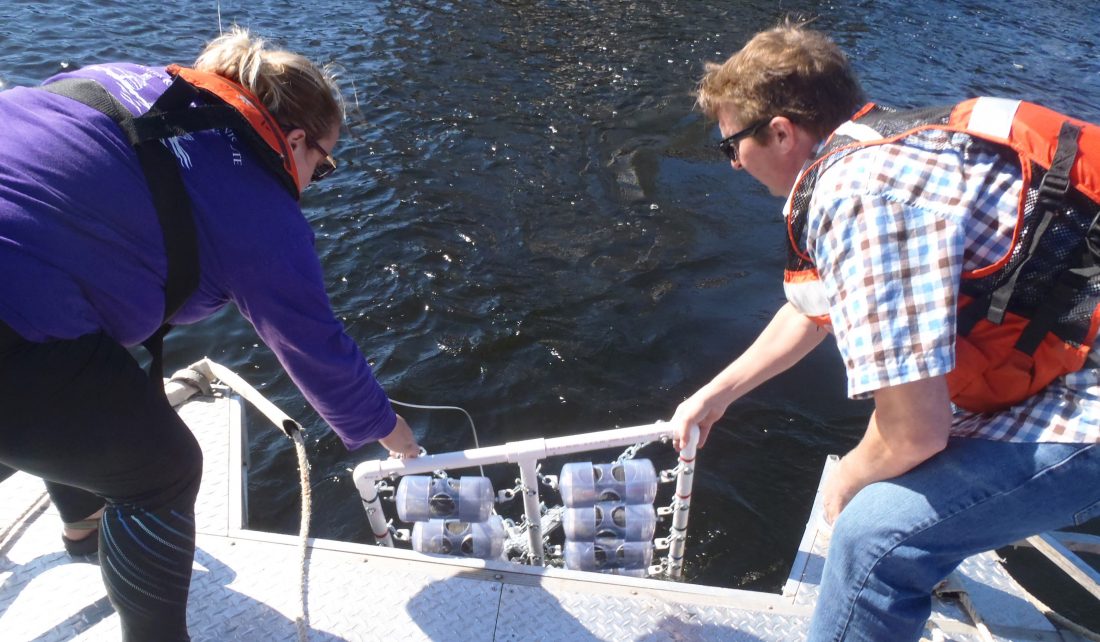
Ever-present in our world, it’s not surprising that plastics have been found in waterways virtually everywhere, mostly showing up as microplastics. Another group of contaminants, PFAS (per- and polyfluoroalkyl substances) are, likewise, being detected in the environment all over the world.
All of these contaminants pose concerns on their own, but now research funded by Illinois-Indiana Sea Grant has found that PFAS can stick to microplastic particles in the water, increasing the likelihood that they will end up in the food web.
PFAS are human-made chemicals that are used in many common products such as non-stick cookware, pizza boxes and stain repellent fabric. Qualities that have made them useful—for example, they are very stable and are resistant to water and oil—can contribute to concerns about PFAS. They don’t easily break down in lakes, rivers, wildlife and people. PFAS can have health effects, such as increasing the risk of cancer, decreasing fertility, and impacting growth and learning in infants and children.
Plastics can break down in the environment to microscopic size or they can enter lakes and rivers as microplastics already—for example, as tiny fibers that wash off our clothing. Once in the environment and our waters, microplastics stick around, and like PFAS they do not easily biodegrade.
John Scott, an analytical chemist at the Illinois Sustainable Technology Center, led a team of researchers to understand the extent to which PFAS and other contaminants attach to microplastics in waterways.
His team used three common types of plastic, testing them in the waters of Muskegon Lake, which sits adjacent to Lake Michigan along the Michigan coast. They also did similar testing in a controlled environment using laboratory water.
Microplastic samples were submerged in the nearshore waters of the channel connecting the two lakes and in the middle of Muskegon Lake, for one month and three months in both locations, and in the laboratory for one month.
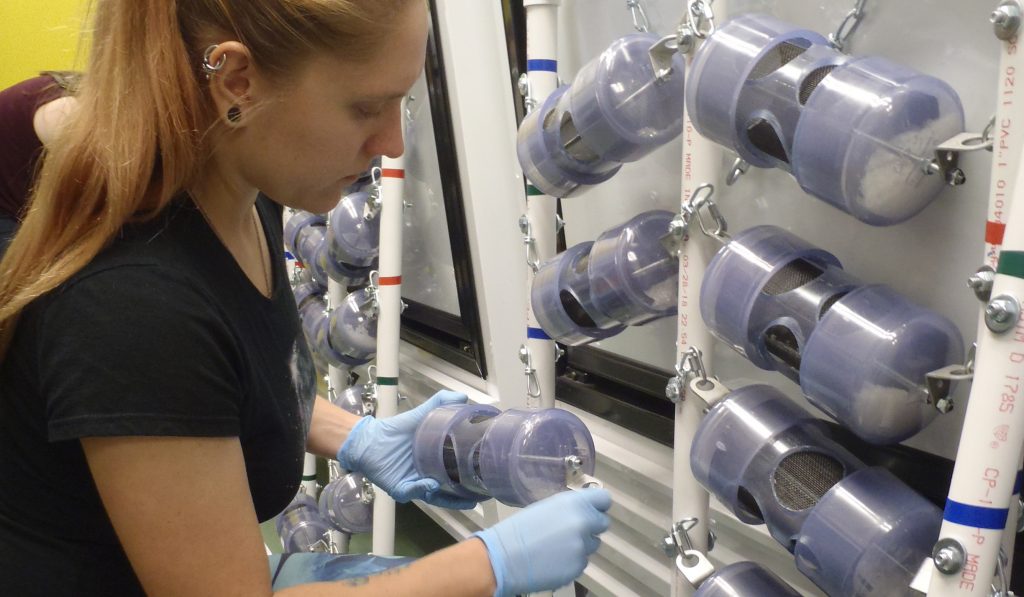
The researchers found that regardless of location, length of time or type of plastic tested, PFAS in Muskegon Lake adhered to microplastic particles—ranging from .052 nanogram to .87 nanogram of PFAS for each gram of plastic. Interestingly, the amount of PFAS sticking to the microplastic in laboratory water was notably less.
“The difference may be due to associated organic matter or the presence of metals or biofilm, which is a collection of bacteria that grows on microplastic particles in the lake, making the surface easier to stick to,” said Scott. “This would also explain the wide variability that we found in PFAS concentrations on microplastic samples that were identical in substance and treatment. We did not find this degree of variability in the controlled experiments.”
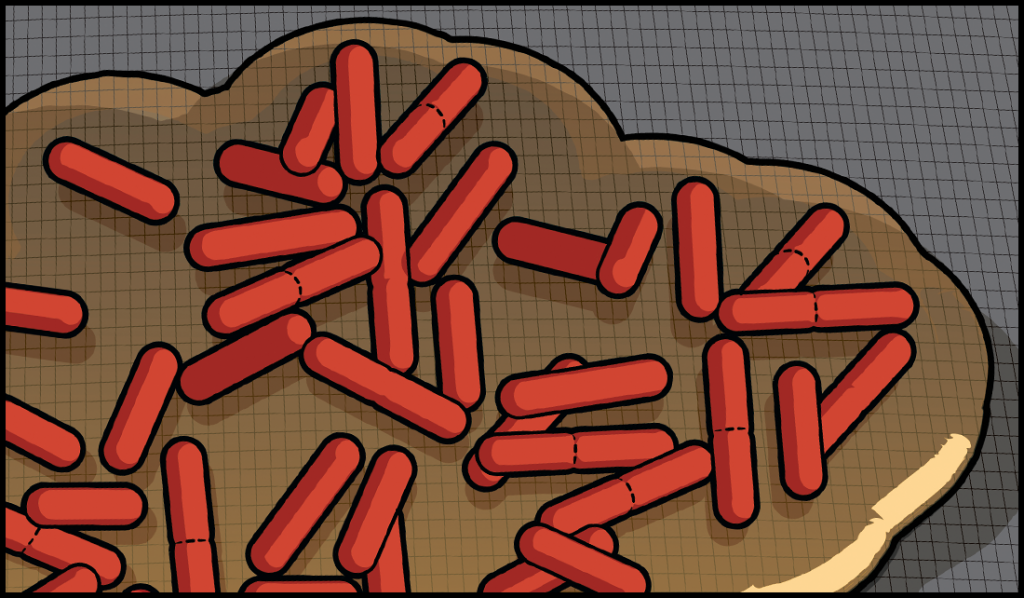
Scott points out that the concentration of PFAS they found attached to microplastics in the study is quite low—for perspective, a nanogram is a billionth of a gram—but there is more to the story. “We submerged our samples for limited time, but some studies have estimated that half of microplastics in the environment have been there for 10 to 15 years. And many of these plastic particles in the water are smaller than we used in this study, so with similar mass they have more surface area, which could result in more adsorption.”
Another consideration is that PFAS are only one group of chemicals that can attach to microplastics. Scott said, “We don’t know the implications of what could be a cocktail of contaminants—like PCBs or PAHs—adhering to these particles and ingested by fish or other organisms.”
At the same time, many plastics may already contain additives such as heavy metals, flame retardants and plasticizers that can further exacerbate this issue. “These microplastics-associated pollutants can act synergistically when an organism is exposed to them,” said Scott.
Recent IISG-funded research at Loyola University has shown that fish in three Lake Michigan tributaries are ingesting microplastics. Biologists John Kelly and Tim Hoellein found that 85% of the fish tested contain, on average, 13 pieces of microplastic in their digestive tract.
Does this translate to a level of concern for fish regarding PFAS and other chemicals that may be in these waters and may be attached to microplastics?
“We just don’t know,” said Scott. “We don’t know if PFAS ingested on microplastics stay with the fish, we don’t know at what rate fish ingest microplastics and we don’t know what concentrations in fish are a cause for concern. This project highlights that, in addition to focusing on relevant microplastic concentrations, further studies need to consider environmentally exposed microplastics.”
ISTC provides science information at public microplastics meeting
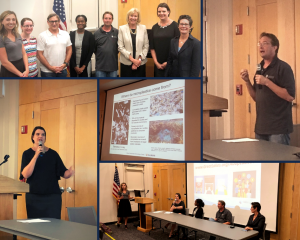 ISTC was one of several expert organizations invited to provide information on microplastics at a public meeting hosted by Illinois State Senator Julie Morrison in Highland Park, IL, on August 14, 2019.
ISTC was one of several expert organizations invited to provide information on microplastics at a public meeting hosted by Illinois State Senator Julie Morrison in Highland Park, IL, on August 14, 2019.
Representatives from the Illinois Environmental Council, Shedd Aquarium, and the Alliance for the Great Lakes participated in the event.
ISTC researcher John Scott discussed the current state of knowledge within the scientific community. He also discussed the current ISTC research on the topic.
Members of the public also asked questions and provided comments on the microplastics pollution issue. Two major themes arose from this discussion:
Do microplastics impact human health?
Panel consensus: There is a major gap in knowledge about the impact that microplastics have on human health. There are a few literature review studies available from epidemiology data, but no long-term health studies have been conducted on the impact to humans of exposure to microplastics.
What can we do to stop pollution and clean up microplastics?
Panel consensus: Shedd Aquarium wants to become a zero waste leader in the community to show businesses and organizations that reducing plastic use is not only possible, but also manageable. ISTC suggested that waste-to-energy processes, such as pyrolysis or gasification, could be a better alternative than landfilling plastic waste. Policies could be implemented to assist in the transition away from plastics, particularly single-use plastics for non-medical/non-disability purposes.
100 Plastic Rivers project tracks the sources of plastic pollution from river to sea
Plastic pollution has become recognized as a major environmental challenge, particularly in oceans. Recent evidence also shows that plastics are also present in freshwater ecosystems, including the Great Lakes. This not only affects human health and aquatic ecosystems, but also provides another pathway for plastics to enter marine environments.
A global initiative called the 100 Plastic Rivers Project investigates how plastics are transported and transformed in rivers and how they accumulate in river and estuary sediments, where they can leave a long-lasting pollution legacy. Researchers at the University of Birmingham lead the project.
Scientists at ISTC and at the Illinois State Water Survey (ISWS) are participating in the 100 Plastic Rivers Project as part of a larger collaboration with the University of Birmingham. One goal of the project is to collect water samples to test for microplastics from 100 different rivers from around the world. ISTC and ISWS researchers have collected water from two rivers in Central Illinois and are recruiting other U.S. researchers to join the project.
Researchers who are interested in collecting samples for the project can contact Dr. Holly Nel at the University of Birmingham.
Registration is Open for Emerging Contaminants Conference
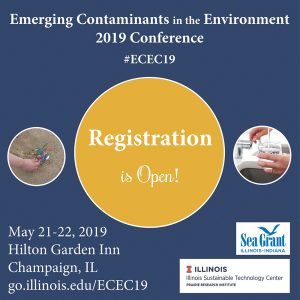 Join us on May 21-22 for the 2019 Emerging Contaminants in the Environment Conference (ECEC19). Registration will be open until May 3. View the draft agenda on the ECEC19 website.
Join us on May 21-22 for the 2019 Emerging Contaminants in the Environment Conference (ECEC19). Registration will be open until May 3. View the draft agenda on the ECEC19 website.
About the Conference
ECEC19 will be held on May 21-22, 2019, at the Hilton Garden Inn in Champaign, IL. This year the conference will expand beyond the aquatic environment to also include air and soil studies along with effects on human and animal health.
The conference will feature presentations and posters on the latest in emerging contaminant research, policies, and outreach. In addition, there will be plenty of opportunities for discussion and networking with those interested in all aspects of emerging contaminants in the environment.
Researchers, educators, businesses, government officials, regulatory agencies, policy makers, outreach and extension professionals, environmental groups, members of the general public, and medical, veterinary, and public health professionals are encouraged to attend the conference.
The Illinois Sustainable Technology Center and the Illinois-Indiana Sea Grant are cohosting this conference.
Keynote Speakers
- Thomas Bruton – PFAS Research and Policy Lead, Green Science Policy Institute
- Robert C. Hale – Professor of Marine Science, Virginia Institute of Marine Science
- Susan D. Richardson – Arthur Sease Williams Professor of Chemistry, University of South Carolina
Panelists
- Thomas Burton – PFAS Research and Policy Lead, Green Science Policy Institute
- Iseult Lynch – Professor and Chair of Environmental Nanosciences at the School of Geography, Earth and Environmental Sciences, University of Birmingham
- Yujie Men – Assistant Professor in Civil and Environmental Engineering at University of Illinois, Urbana-Champaign
- Katie Nyquist – Principal Planner for the Contaminants of Emerging Concern Initiative at the Minnesota Department of Health
- Heiko Schoenfuss – Director of Aquatic Toxicology Laboratory and Professor of Anatomy at St. Cloud State University
- Krista Wigginton – Assistant Professor in the Department of Civil and Environmental Engineering at the University of Michigan
Read more about the panelists.
Microplastic contamination found in common source of groundwater, researchers report
by Lois Yoksoulian – Physical Sciences Editor of U of I News Bureau
Microplastics contaminate the world’s surface waters, yet scientists have only just begun to explore their presence in groundwater systems. A new study is the first to report microplastics in fractured limestone aquifers – a groundwater source that accounts for 25 percent of the global drinking water supply.
The study identified microplastic fibers, along with a variety of medicines and household contaminants, in two aquifer systems in Illinois. The findings are published in the journal Groundwater.
“Plastic in the environment breaks down into microscopic particles that can end up in the guts and gills of marine life, exposing the animals to chemicals in the plastic,” said John Scott, a researcher at the Illinois Sustainable Technology Center and study co-author. “As the plastics break down, they act like sponges that soak up contaminants and microbes and can ultimately work their way into our food supply.”
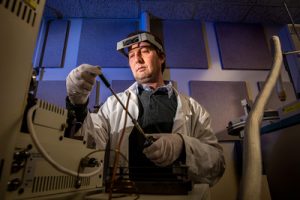
Groundwater flows through the cracks and voids in limestone, sometimes carrying sewage and runoff from roads, landfills and agricultural areas into the aquifers below, Scott said.
The researchers collected 17 groundwater samples from wells and springs – 11 from a highly fractured limestone aquifer near the St. Louis metropolitan area and six from an aquifer containing much smaller fractures in rural northwestern Illinois.
All but one of the 17 samples contained microplastic particles, with a maximum concentration of 15.2 particles per liter from a spring in the St. Louis area, the study reports. However, deciphering what that concentration means is a challenge, Scott said. There are no published risk assessment studies or regulations.
The researchers did find, however, that concentrations from their field areas are comparable to those of surface water concentrations found in the rivers and streams in the Chicago area, said Samuel V. Panno, an Illinois State Geological Survey researcher and lead author of the study.
“The research on this topic is at a very early stage, so I am not convinced we have a frame of reference to state expectations or bounds on what is considered low or high levels,” said Tim Hoellein, a biology professor at Loyola University Chicago and study co-author. “Our questions are still basic – how much is there and where is it coming from?”
The researchers identified a variety of household and personal health contaminants along with the microplastics, a hint that the fibers may have originated from household septic systems.
“Imagine how many thousands of polyester fibers find their way into a septic system from just doing a load of laundry,” Scott said. “Then consider the potential for those fluids to leak into the groundwater supply, especially in these types of aquifers where surface water interacts so readily with groundwater.”
There is still a monumental amount of work to be done on this subject, Scott said. He anticipates that microplastic contamination in both surface water and groundwater will be a problem for years to come.
“Even if we quit plastics cold turkey today, we will still deal with this issue for years because plastic never really goes away,” Scott said. “It is estimated that 6.3 billion metric tons of plastic waste have been produced since the 1940s, and 79 percent of that is now in landfills or the natural environment. To me, it is such a weird concept that these materials are intended for single use, yet they are designed to last forever.”
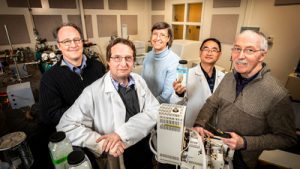
Walton R. Kelly of the Illinois State Water Survey; Wei Zhang and Nancy Holm of ISTC; Rachel E. McNeish of California State University, Bakersfield; Timothy J. Hoellein of Loyola University, Chicago; and Elizabeth L. Baranski of the League of Women Voters of Jo Daviess County also contributed to this research. The ISGS, ISWS and ISTC are part of the Prairie Research Institute at the University of Illinois at Urbana Champaign.
The League of Women Voters of Jo Daviess County, ISGS, ISWS, ISTC, Illinois-Indiana Sea Grant of the National Oceanic Atmospheric Administration and the National Science Foundation supported this research.
Persistent Organic Pollutants on Microplastics Project expanded to include per- and polyfluoroalkyl substances
The Great Lakes are an important water and food source for both humans and animals. Anthropogenic contaminants such as microplastics, pharmaceuticals, personal care products, and per- and polyfluoroalkyl substances (PFAS) are of increasing concern because of their potential impact on the environment and human health. Scientists lack understanding about many aspects of how these recently identified contaminants interact with the environment, aquatic species, and other potential contaminants.
With new funding from Illinois-Indiana Sea Grant, Illinois Sustainable Technology Center (ISTC) researcher John Scott and his team will be able to expand their research to include more environmental contaminants. With their current project on persistent organic pollutants in Lake Muskegon, they are studying the effects of microplastic type and deployment time in the sediments and the water column on sorption of persistent organic pollutants (POPs) to the microplastic particles. This on going investigation includes legacy contaminants like chlorinated pesticides, polybrominated biphenyl ethers (PBDEs), polychlorinated biphenyls (PCBs), and polycyclic aromatic hydrocarbons (PAHs). The new funds will also allow the team to look at adsorption of per- and polyfluoroalkyl substances (PFAS) on the microplastics. PFASs are being found to be ubiquitous in the environment. This study will look at the role microplastics may play as a carrier of these compounds disperse them in water and sediment.

